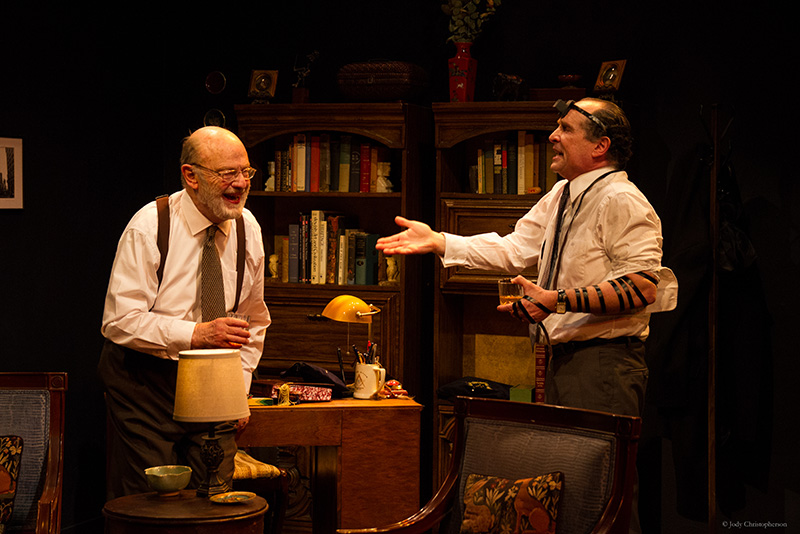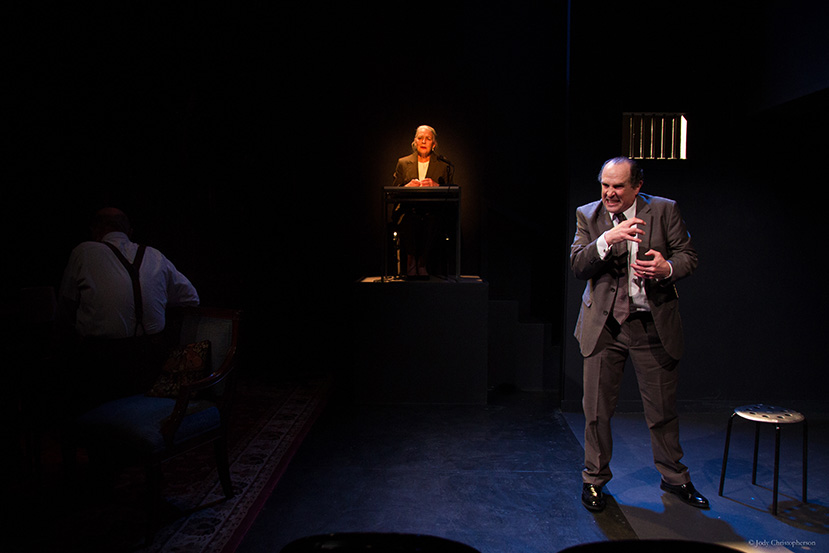Few recent cases of financial crime captured the public’s imagination as much as the swindling of Bernie Madoff. Deb Margolin’s Imagining Madoff revisits the monumental case through the eyes of Madoff himself; Galkin, a Jewish Holocaust survivor; and Madoff’s secretary. Originally written for Theater J in Washington, DC, the somewhat controversial play had its New York premiere this past spring at 59E59. Directed by Jerry Heymann, the production in New York relied heavily on the designers to transform a tiny theater into a space that could hold a play dealing with giant ideas. The play demands three distinct spaces (in three separate time periods) for the three characters to occupy simultaneously: Madoff’s cell, Galkin’s study, and the space for the unnamed secretary’s testimony in front of the Securities and Exchange Commission. But on the tiny stage at 59E59 that would prove to be an incredible challenge.
Imagining Madoff is set designer Dara Wishingrad’s fourth collaboration with playwright Deb Margolin. “She [Margolin] asked me to design Imagining Madoff a couple of years before the New York dates were set, so we'd been talking about it that long,” she says. Wishingrad came to design via dance and choreography. Her start in design was “in art directing large scale, blue chip corporate and private events like Super Bowl, The Ryder Cup Golf Tournaments, the US Open, charity balls, celebrity weddings and events for Lawrence Fishburne, Donna Karan, Gloria & Emilio Estefan, and others. Eventually, I moved over into designing for film and theatre, collaborating with Michael Urie, Nia Vardalos, Charles Busch, John Leguizamo, Kent Nicholson, Leslie Lee, Charles Strauss, Folksbiene Yiddish Theatre, and others.”
All of this varied experience certainly helped Wishingrad approach the complex needs of Margolin’s play in the very small theater at 59E59. “The tiny space had to drive the design as much as the action did,” she explains. “I sat in the theatre for a long time that first visit, contemplating the space and sketching ground plan and image ideas. Jerry Heymann our director, Deb, and I went back and walked through the action and some of my preliminary ideas. As I spent more time in the space, I began to see that the walls, which at first felt like they were going to be closing in on our actors, were actually this beautiful, deep blue with a wonderful textural history.” Wishingrad also let her film experience drive her process, imagining the theater as a kind of location itself; she “could lean into this deep blue space as the conceptual container for the play and that it could hold it beautifully. Anything built would have to disappear into the theatre rather than sit on top of it. I began to see the three distinct qualities of texture and light for each of the characters contrasting with or emerging from the deep blue.” And so, Wishingrad got to return to her original impulse and raise the secretary up to make space for the other two areas: “Since the dialogue is so intense and the actors would be playing basically in the laps of the audience, the set needed to cradle the drama, and I did not want anything about the set to leap out in front of that relationship.”

Creating realistic spaces in such tight confines was also challenging. Rendering these worlds required a lot of furniture and set dressing. Wishingrad knew from the beginning that she has to be very specific about both the look and the size of each object. Galkin’s study, for example, required the most furniture, had the most action and was the only part of the set that needed to hold two performers at the same time. “And there was absolutely no wiggle room. In order to fit everything into the allotted space on stage and maintain what was needed for the blocking, all of his furniture had to be smaller than what is typical without looking miniature in relation to the two actors in the scenes there.” The easy chairs, for example, had 24'' footprints rather than the typical 30'' footprint. “Because there was no budget for custom furniture, this very specific furniture also had to also fall within a very narrow price point, so there was a whole lotta ‘not this, not this’ going on!” The study also had to feel warm and personal, like “it was a haven, yet it could not overpower the other two parts. Happily, I found the perfect, affordable carpet that was the exact size of his area's footprint and it really both pulled it together and set it apart from the other, institutional areas and yet still go dark when it needed to.”
The play also served as very fertile material for Wishingrad: “One of the first images I had for the play was of the Secretary being elevated, rising high above and separated from the rest of the action to live on her own plane, draped in the slide projection images that she is being required to comment on.” She and Heymann used artistic references to create a shared vocabulary for their inspirations, including Joseph Beuys and Cy Twombly. “Both were roughly from the same era as Galkin and Madoff and each did these amazing kinetic chalkboard drawings. I loved the sketchy and temporary nature of the chalk drawings, and with the theatre being much like a blackboard, we discussed a chalked scenic idea but it was going to be too heavy-handed. I had planned on some graffiti in Madoff's cell so we ended up with Cy Twombly-inspired prison graffiti.

“All of the set dressing for Galkin's Study came from the home of a dear friend, actor and activist Dolores Weisel who had recently passed away after a long and happy life,” says Wishingrad. “Dolores was of the same generation with similar sensibilities as the Galkin character and her family graciously let me use many of her belongings and artwork in the design of this set. This was not only a boon to the design but as her friend, I was so happy to be able to honor and celebrate her this way. She would have been thrilled!”
Wishingrad is pleased with the results, even within their limitations: “As often happens in these situations, the beauty of the environment comes from what is left out or taken away rather than added.” She was able to satisfy the needs of the production with deeply detailed layers of set dressing rather than fancy tricks and moving scenery. She brought the world to life: “Hershey kisses in the candy bowls, Dolores' miniature dreamcatcher and ‘I Voted’ sticker on the desk, books, tchotkes and pencils with personality and history...it gave the actors a more meaningful environment to play in and the audience was close enough so they could see these details.”
In order to make this small space and its subtle design work, Wishingrad was dependent on her close collaboration with lighting designer Michael O’Connor. “We were of like mind about designing the play from the start. I feel very lucky to have worked with Michael,” she says. “He had vision and an attunement to detail that was magnificent, and he had worked in the space before and was very familiar with its limitations. His light made it all just so gorgeous, balancing the individual spaces with lovely spills into the other characters' areas during different points in the action. His design was like a watercolor painting.”
Stay tuned for Part Two for more on O'Connor's lighting design.
Additional Team
Associate Set Designer: Brett Calvo
Costume Designer: Kara Branch
Sound Designer: Andy Evan Cohen
Propmaster: Leila Ben Abdallah
Production Manager: Lauren Parrish
Builder: TJ Craftsman
Electrician: Maryam Sweirki